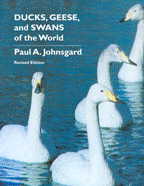Papers in the Biological Sciences

Ducks, Geese, and Swans of the World by Paul A. Johnsgard
Date of this Version
2010
Document Type
Book Chapter
Abstract
Eider (Common Eider) ● King Eider ● Spectacled Eider ● Steller Eider ● Labrador Duck ● Harlequin Duck ● Long-tailed Duck (Oldsquaw) ● Black Scoter ● Surf Scoter ● White-winged Scoter ● Bufflehead ● BroBarrow Goldeneye ● Common Goldeneye ● Hooded Merganser ● Smew ● Brazilian Merganser ● Red-breasted Merganser ● Chinese Merganser ● Goosander (Common Merganser) ● Auckland Island Merganser
The sea duck tribe, which here includes the eiders, consists of 20 species that are all superb diving birds. They are found in fresh-water as well as marine habitats, and primarily have Northern Hemisphere distribution patterns. Except for the two isolated Southern Hemisphere species, all of the sea ducks have considerable sexual dimorphism in plumage. Males in breeding plumage are usually elaborately patterned, often with predominantly black and white markings, which probably serve very well to localize and identify these birds at considerable distances in their marine environments. However, iridescent coloration is generally limited to the head, and the wing speculum patterns, instead of being iridescent, are generally white and black. Nesting is usually done on fairly open shoreline or in grassy tundra, as in the eiders and long-tailed duck, or in cavities, under heavy brush, or in similar well-concealed locations, as in the goldeneyes, mergansers, and harlequin duck. Females of the ground-nesting forms approach the patterns found among female dabbling ducks in their cryptic coloration, and the downy young of these species are also rather brownish and obscurely patterned. Females of the hole-nesting species are more uniformly brownish and their ducklings are frequently contrastingly spotted with white and dark markings.


Comments
In Ducks, Geese, and Swans of the World, by Paul A. Johnsgard. Electronic edition copyright © 2010 Paul A. Johnsgard.